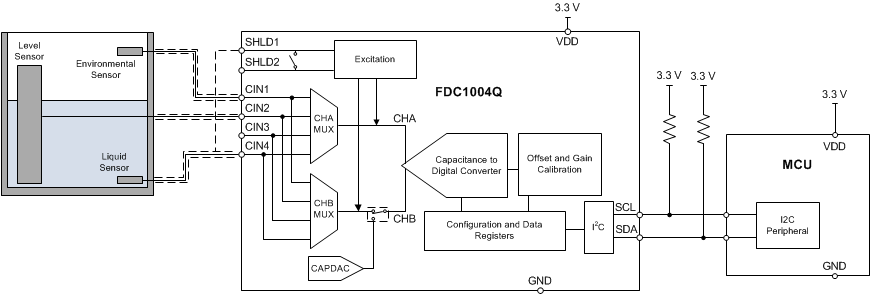SNOSCZ4 April 2015
PRODUCTION DATA.
- 1 Features
- 2 Applications
- 3 Description
- 4 Typical Application
- 5 Revision History
- 6 Pin Configuration and Functions
- 7 Specifications
- 8 Detailed Description
- 9 Applications and Implementation
- 10Power Supply Recommendations
- 11Layout
- 12Device and Documentation Support
- 13Mechanical, Packaging, and Orderable Information
Package Options
Mechanical Data (Package|Pins)
- DGS|10
Thermal pad, mechanical data (Package|Pins)
Orderable Information
1 Features
- Qualified for Automotive Applications
- AEC-Q100 Qualified With the Following Results
- Device Temperature Grade 1: -40°C to 125°C Ambient Operating Temperature Range
- Device HBM ESD Classification Level 2
- Device CDM ESD Classification Level C5
- Input Range: ±15 pF
- Measurement Resolution: 0.5 fF
- Maximum Offset Capacitance: 100 pF
- Programmable Output Rates: 100/200/400 S/s
- Maximum Shield Load: 400 pF
- Supply Voltage: 3.3 V
- Temp Range: –40° to 125°C
- Current Consumption:
- Active: 750 µA
- Standby: 29 µA
- Interface: I2C
- Number of Channels: 4
2 Applications
- Proximity Sensor
- Gesture Recognition
- Automotive Door / Kick Sensors
- Automotive Rain Sensor
- Remote and Direct Liquid Level Sensor
- High-resolution Metal Profiling
- Rain / Fog / Ice / Snow Sensor
- Material Size Detection
3 Description
Capacitive sensing with grounded capacitor sensors is a very low-power, low-cost, high-resolution contact-less sensing technique that can be applied to a variety of applications ranging from proximity sensing and gesture recognition to material analysis and remote liquid level sensing. The sensor in a capacitive sensing system is any metal or conductor, allowing for low cost and highly flexible system design.
The FDC1004Q is a high-resolution, AEC-Q100 qualified, 4-channel capacitance-to-digital converter for implementing capacitive sensing solutions. Each channel has a full scale range of ±15 pF and can handle a sensor offset capacitance of up to 100 pF, which can be either programmed internally or can be an external capacitor for tracking environmental changes over time and temperature. The large offset capacitance capability allows for the use of remote sensors.
The FDC1004Q also includes shield drivers for sensor shields, which can reduce EMI interference and help focus the sensing direction of a capacitive sensor. The small footprint of the FDC1004Q allows for use in space-constrained applications. The FDC1004Q is available in a 10-pin VSSOP package, which allows for optical inspection in production, and features an I2C interface for interfacing to an MCU.
Device Information(1)
| PART NUMBER | PACKAGE | BODY SIZE (NOM) |
|---|---|---|
| FDC1004Q | VSSOP (DGS) | 3.0 mm x 3.0 mm |
- See the orderable addendum at the end of the datasheet for orderable part numbers.
4 Typical Application
